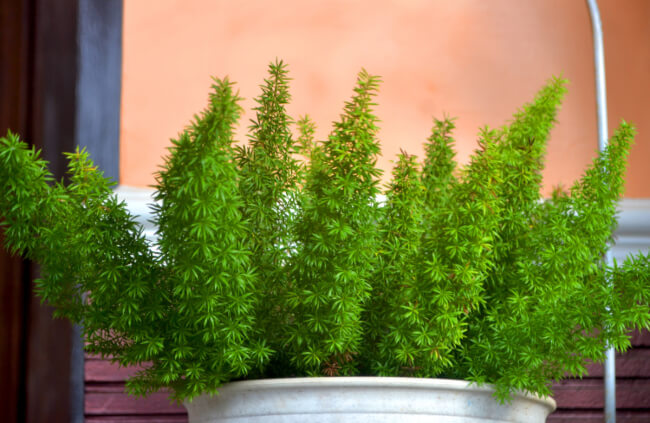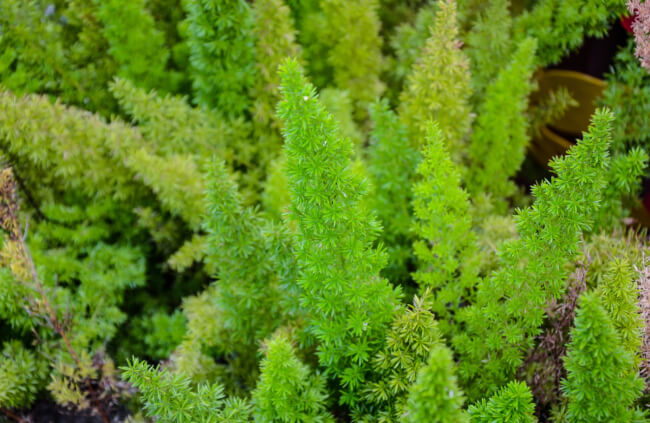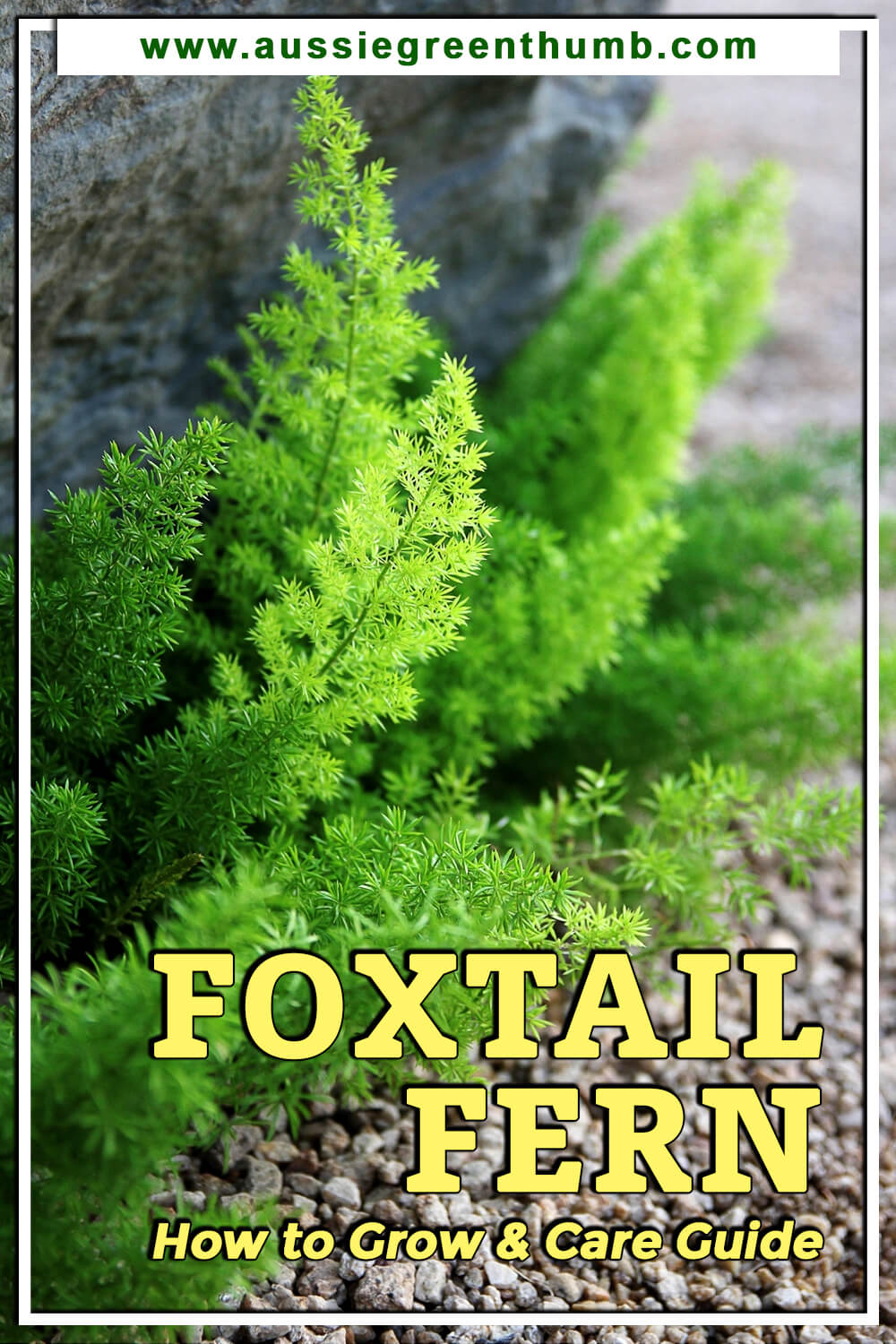Fascinating, fluffy, and easy to grow and care for, the foxtail fern is an excellent option for those looking to spruce up their gardens and add some lively lusciousness to their homes.
For beginner growers looking at how to grow foxtail fern, this article will outline all the necessary steps and processes to follow and offer some foxtail fern care tips.
More...
What is a Foxtail Fern?

Asparagus densiflorus, also known as foxtail fern and plume asparagus, are perennial evergreens part of the asparagus family. It is a great pick for any outdoor or indoor scenario or setting with pine needle-like leaves, thick and bushy stems, and vibrant green colours.
Originating from South Africa, the foxtail fern utilises seeds to reproduce rather than spores. Boasting beautiful feather-like stems, these plants produce white flowers that will later become tiny red berries during spring.
Please note that foxtail fern berries are toxic to humans and pets. Foxtail ferns can be misleading as one would think by looking at them that they are delicate or fragile. However, this is not the case.
They are aggressive growers and can easily dominate garden beds. Should you wish to plant them in a pot, they can be much more manageable. However, planting them in a garden will require more effort and attention.
If you are looking at how to grow foxtail fern, let’s first take a look at a few key components this plant requires:
- Requires partial shade inland & full sun on the coast
- The soil should be well-draining
- pH within the ground should be moderately acidic
- You don’t need to water thoroughly as foxtail ferns store water within their tuberous roots
- Keep them slightly moist so that the soil can dry between watering sessions
- There is no need for excessive use of fertiliser. Just use a good, organic compost
- The foxtail fern can grow as tall as 1 metre
- If planted in a pot, try to turn the pot slightly now and then to guarantee even sun disbursement
- The lowest temperature this plant can withstand is around 10°C
How to Grow Foxtail Fern in Australia

Luckily, growing these fluffy plants is quite simple. They grow best in temperatures between 18°C to 23°C. Using a high-quality potting mix formulated for tropical plants is recommended when planting.
This plant is naturally fast-growing, so avoid over-fertilizing. As it is such an aggressive grower, frequent pruning is needed, especially to curb growth upwards to retain a pleasing, bushy appearance.
Avoid using a pot that is too big initially as this can lead to too much water retention within the soil and, therefore, rot. Start with a modest pot size, and you can always re-pot into a larger container later in the process.
When the roots begin to grow out of the soil, you will know it is time for a larger home for your plant. When moving over to a larger pot, try to avoid going bigger than about 5 cm to avoid the growth becoming too aggressive.
Initially, the plant will need more shade, but it should become more immune to drought once matured. In the colder winter months, you can allow more sunlight throughout the day.
Should you find that the plant is becoming too bushy and the larger stems begin to overshadow the new growth, you can split the foxtail fern into two pots as long as you separate the roots gently.
You can also cut away more giant stems, especially if they have started to brown.
Propagating Foxtail Fern
Using the red berries it produces, you can propagate using the seeds found within the berries. This is the easiest way to go about it. We recommend using division and propagating in the spring. Your first watering should be abundant.
Caring for Foxtail Fern

Watering Needs
As the foxtail fern originates from a temperate climate, watering can be thorough so long as you let the top 7.6 to 10 cm dry before your next watering.
If potted, allow good drainage to avoid soaked soil. Should you live in a region that only gets limited dry months, this plant is perfect as its tuberous roots store plenty of water and nutrients.
In winter, you can water far less frequently. Just be sure not to let the soil dry out completely. Watering with ambient temperate water is recommended. You can even mist the plant if you prefer this method.
Humidity & Temperature
Again, this forest plant is native to South Africa, which has a hot, humid climate for the most part. A 40% to 50% humidity level is recommended.
You can achieve this by placing the plant on a wet pebble tray or regularly misting the fronds. Try to avoid placing the foxtail fern near hot or cold air vents within your home if potted indoors.
As mentioned earlier, ideal temperatures are between 18°C to 23°C.
Fertilising Foxtail Fern
Fertilise your soil once a year to avoid yellowing leaves for matured ferns. Foxtail ferns do well with both liquid fertiliser at half strength or slow-release fertiliser.
We also recommend using rich, organic compost. Fertilise in the spring and top up as needed throughout the growing months.
Pests
Thankfully, the foxtail fern is known not to be susceptible to any pests or diseases.
Common Uses
- Garden beds
- Rock gardens
- Hanging Baskets
- Indoor houseplants
- Floral arrangements
Asparagus densiflorus Frequently Asked Questions

Can foxtail fern take full sun?
Yes. It can also thrive in partial shade. Overall, it is not a fussy plant.
How do you make foxtail fern bushy?
Regular pruning, specifically of the upwards stems, can ensure a more bushy and luscious appearance.
Do foxtail ferns need humidity?
Yes, as they are tropical plants, medium humidity and moist soil are ideal.
How often should I water my foxtail fern?
About once per week should suffice.
Is foxtail fern poisonous to humans and dogs?
Yes, the red berries are poisonous to humans and pets.
How far apart do you plant foxtail ferns?
Spacing them around 45 to 60 cm apart is ideal.
Are foxtail ferns invasive?
They certainly can be due to their aggressive growth and extensive root system. Spacing them properly in your garden is recommended.
What goes well with foxtail fern?
The aeonium palm, sago palm, and jade plant are suitable matches beside your Foxtail.
Do foxtail ferns clean the air?
Some studies have suggested that they can help clean the air of toxins such as ammonia and benzene.
Do you want to add more ferns to your garden mix? See our growing guide list below:

Wrapping Up Our Foxtail Fern Guide
Easy to grow and propagate, the foxtail fern is an excellent option for an attractive, forest-style plant for your garden or home. Being evergreen, they are brilliant for decorative purposes and do not take ill easily.
With its thick and bushy stems, it is perfect for adding some luscious beauty to your garden or home without the hassle of intensive care or pest control. They are aggressive growers and are not fragile, meaning you do not need to be an expert gardener to enjoy growing foxtail ferns.
Published on June 24, 2023 by Maisie Blevins
Last Updated on January 27, 2024




